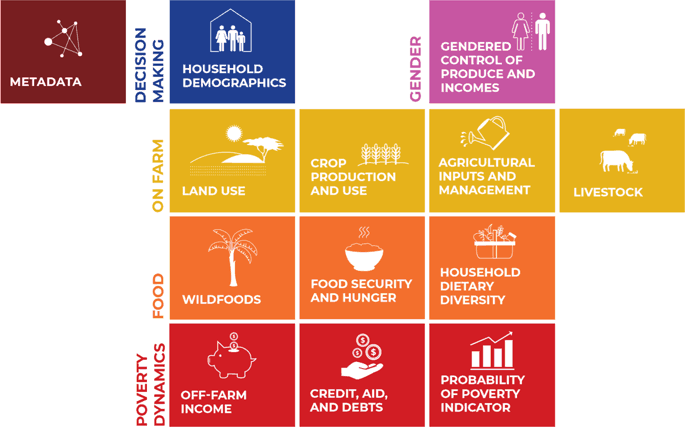A tool for all seasons
Out this week is the first public release of a huge dataset generated by recent surveys of more than 13,000 households in 21 countries using RHoMIS, a novel tool that makes household surveys efficient, robust and comparable.
The tool was co-developed by Mark van Wijk and Jim Hammond, scientists at the International Livestock Research Institute (ILRI), and the data generated by the tool’s use by (literally) dozens of partners.

Key indicator groups (modules) generated by all RHoMIS applications.
Mark van Wijk, a senior scientist at the International Livestock Research Institute (ILRI), and his colleagues are excited to announce the first public release of a dataset generated by surveys of more than 13,000 households in 21 countries using a novel survey tool that van Wijk co-developed, as reported this week in Scientific Data, a peer-reviewed, open-access journal for descriptions of scientifically valuable datasets, and research that advances the sharing and reuse of scientific data, which is part of the Nature Group.
What’s the tool? A rapid, standardized and cost-effective tool employing a minimalist data approach for surveying rural smallholder households and tracking agricultural performance. Rolled out in May 2015, this flexible digital platform is built on open-source software that can be easily modified to meet a range of needs while collecting a core set of data.
The household survey tool includes data storage and analysis functions designed to rapidly characterize the state and change in farming households by a series of standardized indicators. It was designed in response to an expressed need from development practitioners to improve current approaches in targeting and prioritizing intervention options and monitoring farm households.
The big picture Since it was designed in 2015, RHoMIS, which stands for ‘Rural Household Multi-Indicator Survey’, has now been used in Central America; West, East and Central Africa; and South and Southeast Asia to characterize more than 7,000 farm households, evaluate management options, identify locally best-performing farmers, track changes in farm households over time and relate observed changes in farm household performance to changes in farm management and land use.
Use of this streamlined, modular survey tool has greatly reduced the costs of conducting household surveys in the field (traditional household surveys typically takes two to three hours per household) and of the subsequent data analysis and reporting.
How does it work? This farm household survey is conducted on a digital platform using smart phones or tablets using the Open Data Kit suite of software installed on Android-based mobile phones or tablets. Data can be directly uploaded to a web server and an associated set of analysis tools programmed in R extract the data and calculate indicators.
For more information, read the full article about the tool, originally published by ILRI.
February 14, 2020
International Livestock Research Institute (ILRI)




